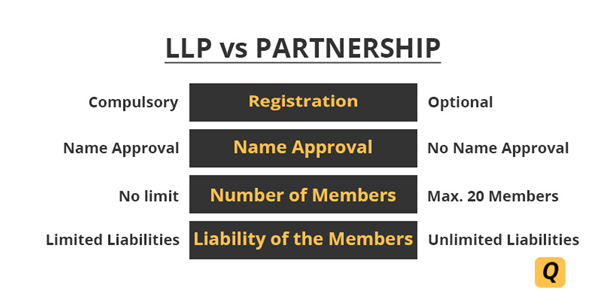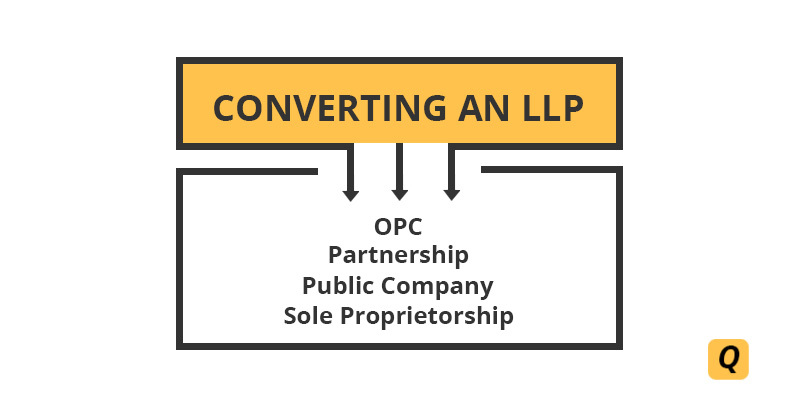Limited Liability Partnership in India
February 08, 2019 by Archi Bhatia
Limited liability Partnership(LLP) is a hybrid corporation that provides the benefit of a company and the flexibility of a partnership. This type of organisation has liability shield and tax pass flexibility. Similar to the partnership firm, LLP also has an LLP agreement which contains the rules and regulation of an LLP.
Introduction of LLP
Limited liability partnership was introduced in India in the year 2009; in an LLP the partners have limited liability which is different from other partnership firms that are responsible for the acts of the other directors as well as all the cases and debts that are filed against the firm.
Structure of LLP
LLP is a body corporate and a separate legal entity from its partners. Such an organisation has perpetual succession. In short, the Limited Liability Partnership provides formation of a business organisation with limited liability to the owners.
As per the Act, the LLP provides the advantages of both the Company and Partnership, and it is the easiest form of business to incorporate and manage.
Nowadays, LLP model is getting more popularity among Startup companies as it is cheaper to run and maintain(lesser Compliance), it offers limited liability, many tax benefits, credibility and above all, it is registered with the Ministry of Corporate Affairs (MCA) as a company.
Features of an LLP
Limited Liability Partnership contains the features of both Partnership firm and Company. Following are the key features which represent LLP.
-
Separate Legal Entity
LLP is a separate legal entity and is liable for its property or assets. The company can sue and be sued but the partners will not liable for any of the dues that are incurred in the suit.
-
Capital Requirement
Raising money in a company is a lot easier than gaining investor for any proprietorship firm or a partnership. An LLP is a regulated company and hence raising capital for the company is a lot easier.
-
Members in Company
An LLP has no upper limit on the number of members/partners in a company which is not a case in a simple partnership firm where some partners cannot exceed 20. The partners in a company are also not liable for the acts of other partners as well.
-
Common Seal
It is upto the partners of LLP to decide whether they want to have a seal or not. If the seal is selected, then it is important that the seal of the company remains within the custody of a responsible officer. The common seal of the company can only be used if at least two of the designated partners of the company are present.
Company Details Required
Following detail of the Limited Liability Partnership should be prepared before the incorporation of a company.
- Capital investment that is to be made in the LLP firm
- The State in which the company is to be registered
- Main Object of the company
- The division of contribution amongst the partners
- The number of partners that are proposed to be included in the LLP
Steps to Register an LLP
The procedure to register an LLP takes upto 7 to 10 days for registration.
Step 1 Application for DIN and DSC
DIN and DSC are an essential aspect of the registration of a company with MCA. Licensing authority certifies the applicant to verify the documents submitted in the online application. The DSC and DIN are necessary for all existing and proposed directors. DIN is necessary as MCA has made it a requirement to serve as a board member.
Step-2 Name Approval
Name approval for the company is done with LLP E-form 1that is filed with the registrar of the company (ROC). On approval of the name, the company professionals can proceed with the filing of the registration application. The availability of the company name is valid for 3 months after which the applicant will have to file a new application to reserve name with MCA.
Step-3 Application with Registrar
After the name approval of the company, the applicant has to make an application with the registrar of companies with form LLP-2 which is an incorporation form. The next form is LLP-3 which is a partnership agreement.
Step-4 Opening Current Account
Once the applicant has received the incorporation certificate they can use it and the PAN and TAN number to open new bank accounts with any of the nationalised or non-nationalised banks.
Advantages of an LLP
LLP is a unique form of business which started on 9th January 2009. Limited Liability Partnership Act 2009, was introduced because it was seen that many people want to do the business but are afraid to open a company due to high compliance. In 2009, Lawmaker introduced Limited Liability Partnership because those who are habitual in running a Partnership can grow their business while doing business as LLP. Following is the comprehensive list of LLP benefits
- No Compulsory Audit
- Low Incorporation cost
- Tax Benefits
- Lesser Compliance
- Separate Legal Entity
For more Benefits visit Advantages of LLP
LLP vs Partnership Firm

Partnership Business is a Traditional form business, and LLP is a modified version of partnership which has some features of Companies as well.
Limited Liability Partnership
- It is registered under the Jurisdiction of Central Government
- In LLP one partner is not liable for the act of the other partner
- All the partners have limited Liability under LLP
- LLP name is registered all over India. No one from any other state can register LLP with the same name
Partnership Firm
- It is registered under the State Government Jurisdiction
- In Partnership Firm all the partners severally and equally liable for the act 1 partner
- In Partnership Firm all the partner face unlimited liability clause
- Partnership Firm name is registered under a State. If anyone wants to incorporate a partnership firm in another state, then they can incorporate it with the same name
Conversion of Business

Partnerships are traditionally preferred when incorporating a business based on the fact that it has a simplified process and has ease of function.
Conversion of an LLP is required because firms need to grow transnational and expand their territorial operational area. Conversion of an LLP can be done as per section 366 of the companies act as there is no such provision providing for the conversion of an LLP.
The section deals with the conversion of firms such as partnership firm and corporative society and such other firms that are not companies but are registered under the companies act.
An LLP requires to submit Form URC-1 with MCA to convert an LLP into a different company, the form should be submitted along with all the required documents.
Compliances for LLP
Post Compliances – Subjected to the Minimum Turnover Criteria
Limited Liability Partnership (LLP) under the Limited Liability Partnership Act, are required to file the following Forms with the Registrar of companies(ROC) every year:
|
S. No. |
Document |
e-Form |
|
1 |
Statement of Account & Solvency |
|
|
2 |
Annual Return |
How to do the Filing
LLPs can do e-Filing in following ways:
The Designated partner (DP) (in the case of LLP) or authorised representative (AR) (in the case of Foreign Limited Liability Partnership (FLLP) can upload the e-Forms on the LLP portal (after registering oneself as a user of the portal) at his convenience from his office/ home. E-filing is the most convenient way of registering an LLP.
Taxation and LLP in India
When we talk about tax implication on LLP various aspects of taxation come to point such as FDI and taxation and Income tax aspects on LLP.
Limited Liability Partnership (LLP) is taxed @30% flat on the profit earned by the LLP. To know more about the responsibilities of designated partners to save from imposing penalties.